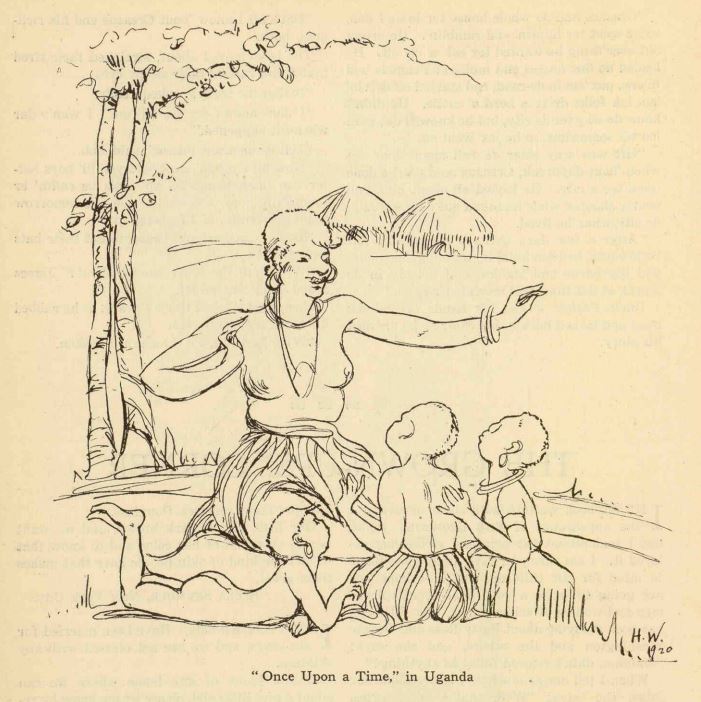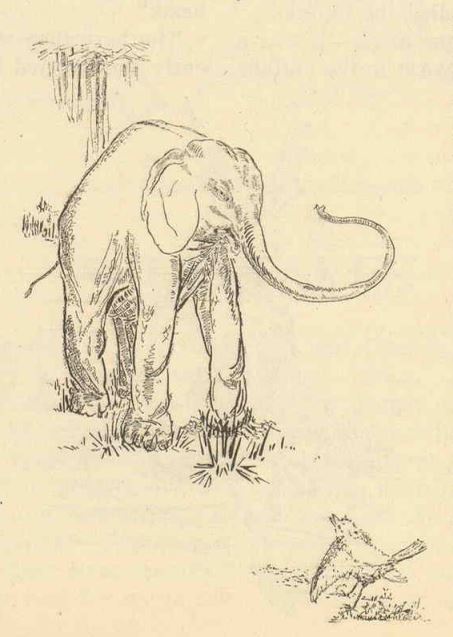The Hare and the Elephant
By Sir Harry Johnston
Annotations by Abby Army

FOLK TALES
The only thing that is nicer than telling a story is to listen to it. Did you ever stop to think that just as you sit very still in the twilight and listen to Father or Mother telling stories, just so children are listening, all over the world,—in Sweden, in India, in Georgia, and in Uganda? I think you probably know where the first three countries are, but maybe it would be best for me to tell you that Uganda is in beautiful, far-off, mysterious Africa.
Some people are specially fond of telling stories about animals. About twenty-five hundred years ago a poor Greek slave, Aesop, told many and amusing tales about the fox and the wolf and all the rest of them. And you High School boys and girls probably have already read the clever animal stories told by Jean de la Fontaine [1] in the seventeenth century.
Now here is a story about animals which African Fathers and Mothers tell to their little sons and daughters. The story is very old and has come down from father to son for many generations and has probably met with almost no changes. Such a story is called a folk tale. There are many folk tales to be gathered in Africa, and Mr. Monroe N. Work, of Tuskegee, has collected very many of them from various sources. This one, “The Hare and the Elephant,” has been selected by Mr. Work from Sir Harry Johnston’s book called “The Uganda Protectorate.”
Folk tales, folk songs, and folk dances can give us—even better than history sometimes—an idea of primitive people’s beliefs and customs.
The Hare and the Elephant
ONCE upon a time the hare and the elephant went to a dance. The hare stood still and watched the elephant dance. When the dance was over, the hare said,
“Mr. Elephant, I can’t say that I admire your dancing. There seems to be too much of you. Your flesh goes flop, flop, flop. Let me cut off a few slices and you will then, I think, dance as well as I.”
The hare cut off some huge slices and went home. The elephant also went home; but he was in agony. At length he called the buffalo and said,
“Go to the hare and ask him to return my slices.”
The buffalo went to the hare and asked for the slices.
“Were they not eaten on the road?” asked the hare.
“I heard they were,” replied the buffalo.
Then the hare cooked some meat,—it was a slice of the elephant, and gave it to the buffalo. The buffalo found it very tender and asked him where he got it.

“I got it at a hill not far from here, where I go occasionally to hunt. Come hunting with me today.” So they went to the hill and set up some snares. The hare then said to the buffalo, “You wait here and I will go into the grass. If you hear something come buzzing ‘Zoo-oo-oo-oo-oo-oo-oo-oo,’ hang down your head.”
The buffalo waited. Presently he heard, “Zoo-oo-oo-oo-oo-oo-oo-oo—”. He hung down his head. The hare threw a big rock, hit the buffalo’s head and killed him. The hare then skinned him and carried home the meat. When the buffalo did not return, the elephant sent an antelope to ask the hare to return his slices. But the hare disposed of him in the same manner as he had the buffalo and carried home his meat. The elephant sent a succession of messengers for the slices, but none of them returned. At last the elephant called the leopard and said, “Go to the hare and ask him to return my slices.”
The leopard found the hare at home. After they had dined, the hare invited the leopard to go hunting on the hill. When they arrived and had set up their snares, the hare said,
“Now you wait here and I will go into the grass. If you hear something come buzzing, ‘Zoo-oo-oo-oo-oo-oo-oo-oo’, hang down your head.”
The hare then went into the grass and presently the leopard heard a buzzing, ‘Zoo-oo-oo-oo-oo-oo-oo-oo’, but instead of hanging down his head, he held it up and a big stone just missed him. Then he hung down his head, fell over and pretended that he was dead. He laughed to himself,
“Ha! ha! Mr. Hare, so you meant to kill me with that stone. I see now what has happened to the other messengers. The wretch killed them all with his ‘Zoo-oo-oo-oo-oo-oo-oo-oo-o’, Nevermind, Mr. Hare, just wait.”

The hare came out of the grass and when he saw the leopard lying stretched out, he laughed and jumped and scraped the ground. “There goes another messenger,” he said. “The elephant wants his slices back. Well, let him want them.”
Having said this, the hare hoisted the leopard on his head and walked off with him. The leopard enjoyed riding on the hare’s head. After the hare had carried him a little way, the leopard put forth his paw and gave the hare a deep scratch. He then drew in his paw and lay quite still. The hare at once understood how matters lay and put down the bundle. He did not, however, pretend that he knew, but said,
“Oh, there seems to be a thorn in the bundle.”
He then roped the bundle very firmly, taking care to tie the paws securely. He then placed the bundle on his head and went along to a stretch of forest. Here he placed the leopard in the woods and went off to get his knife.
As soon as the hare had gone, the leopard tore open the bundle and sat up to wait for the hare’s return. “I’ll show him how to hunt and to say, ‘Zoo-oo-oo-oo-oo-oo-oo-oo, hang down your head’! I’ll show him how to cut slices off my friend, the elephant.” The leopard looked up and saw the hare returning with his knife.
When the hare saw the leopard sitting up, he ran into a hole in the ground.
“Come out,” said the leopard, sniffing vainly at the hole.
“Come in,” said the hare.
The leopard saw that it was useless to try to coax the hare to come out, so he said to a crow that sat on a branch just above the hole, “Mr. Crow, will you watch this hole while I run for some fire to burn out the hare?”
“Yes,” replied the crow, “but don’t be long away, because I will have to go to my nest soon.”
The leopard went for the fire. After a while the hare said,
“I am certain, Mr. Crow, that you are very hungry.”
“Yes, very,” replied the crow.
“Are you fond of ants? If you are, I have a lot of them down here.”
“Throw me up some, please.”
“Come near the hole and I will.”
The crow came near. “Now open your eyes and mouth wide.”
The crow opened his mouth and eyes as wide as he could. Just then the hare flung a lot of dust into them, and while the crow was trying to remove the dust, the hare ran away.
“What shall I do now?” said the crow, as he finished taking the dust out of his eyes. “The leopard will be angry when he finds the hare gone. I am sure to catch it. Ha! Ha! I have it. I will gather some ntengos (poison apples), and put them in the hole. As soon as the leopard applies the fire to the hole. the ntengos will explode and the leopard will think that the hare has burst and died.”
The crow accordingly placed several ntengos in the hole. After some time, the leopard came back with the fire.

“Have you still got him inside?” he asked.
“Yes, sir.”
“Has he been saying anything?”
“Not a word.”
“Now then, hare,” said the leopard, “when you hear ‘Zoo-oo-oo-oo-oo-oo-oo-oo’, hold down your head. Do you hear?” No reply. “You killed all of the elephant’s messengers just as you tried to kill me; but it is all finished now with you. When I say, ‘Zoo-oo-oo-oo-oo-oo-oo-oo-o’, hang down your head. Ha! ha!”
Then the leopard put the fire in the hole. There was a loud explosion. The leopard thought that the hare had burst and died. But instead, the hare was at home making a hearty meal of the last of the elephant’s steaks. None of the other animals ever bothered the hare after that. They remembered what happened to the elephant’s messengers.
Johnston, Harry. “The Hare and the Elephant.” The Brownies’ Book 1, no. 2 (February 1920): 46-48.
[1] Jean de la Fontaine (1621-1695) was a French poet whose fables rank among the highest masterpieces of French literature. You can see some of Fontaine’s fables here.
Contexts
Laura Wheeler (1887-1948) was an American painter and educator who is known for her paintings featuring African American subjects. To supplement her income as a teacher, she took up painting. One year after she died, the Howard University Gallery of Art held an exhibit highlighting her works. See some of Wheeler’s paintings here. Hilda Wilkinson (1894-1981) was an artist and teacher from Washington, D.C. She is known for her paintings and her work as the main illustrator for The Brownies’ Book. You can see some of Wilkinson’s works here.
